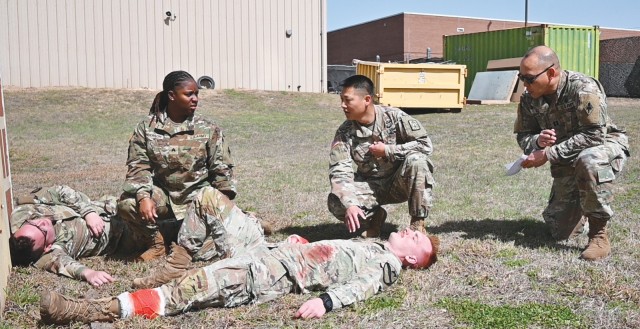
FORT CAVAZOS, Texas — Army chaplains and their religious affairs specialist counterparts work frequently with trauma, both in garrison and in combat areas. Combat Medical Ministry/Emergency Medical Ministry training equips and prepares chaplains to respond to trauma and help others as well as keep themselves healthy.
Thirty-seven chaplains and religious affairs specialists from across III Armored Corps, the Texas National Guard and Reserve units participated in the training held Feb. 24 – Saturday at Fort Cavazos.
“We’re here to show these chaplains and religious affairs specialists how to do proactive religious support in a trauma-laden environment,” said senior instructor Sgt. 1st Class William Rogers, U.S. Army Institute for Religious Learning Graduate School for Army Chaplain Corps Professional Development in Fort Jackson, South Carolina. “It’s about teaching those chaplains and enabling them to do their jobs in the midst of trauma.”
Rogers is part of a four-instructor team that travels from the USA-IRL graduate school to conduct the two-week training.
The Combat Medical Ministry/Emergency Medical Ministry Course falls under the School for Spiritual Care’s Clinical Pastoral Education System.
It focuses on short-term trauma intervention and response to combat casualties, combat stress and emergent/urgent care environments, according to the USA-IRL website.
“The work of a unit ministry team never changes,” Rogers said. “If we can get UMTs that work effectively and efficiently in trauma, then I’ve done my job.”
UMTs conduct their mission in garrison, hospitals and on the battlefield. One constant across all those areas is trauma in its various forms.
Chaplains have three core competencies — nurturing the living, caring for the wounded and honoring the fallen.
“We do all three in this course,” Rogers said.
The course includes a fourth competency often overlooked for and by chaplains and religious affairs specialists — self-care.
“We preach every Soldier needs a chaplain and you are a Soldier, too,” Rogers said. “It’s about serving well versus serving. We have to set ourselves up to do it well.”
At the end of the course’s first week, they learned strategies to care for themselves.
“Self-care is the most important,” Rogers said. “It’s just as important as the trauma piece.”
Chaplain (Capt.) Matthew James Frost, a chaplain at Brooke Army Medical Center in San Antonio, agreed about the importance of self-care for chaplains. After working in trauma rooms, he has learned to identify his own triggers when it comes to trauma and trauma response.
“Self-care is the most important thing we will learn in the course of our careers,” Frost said.

Chaplain (Capt.) Luke Allen, 103rd Chemical Battalion, Kentucky Army National Guard, said the CMM/EMM training was some of the most practical he has received, especially the self-care portion.
“They did a very good job of giving up the doctrine and showing us how to apply it,” Allen said, noting the instructors taught self-care, then released the class early for the day to practice the self-care. “I can’t take care of Soldiers if I’m not taking care of myself.”
However, not all of the training is completed in the classroom.
During the last week of the EMM/CMM course, the chaplains and religious affairs specialists participated in an exercise to evaluate their performance of applying the skills taught in the classroom at the Medical Skills Training Center on Fort Cavazos, Texas.
The hands-on exercise was intentionally chaotic and forced the teams to make quick-second decisions.
“This is about preparing us for our worst day,” said Staff Sgt. Trevor Rhodes, a religious affairs specialist assigned to the Mobilization Support Brigade, III Armored Corps. “I was looking for clarity from the patient on what triage he needed so I can understand the next step and de-escalate myself. You can either stress out or make the most of it and move on.”
For each iteration of the exercise, a UMT of one chaplain and one religious affairs specialist was brought to a simulated battlefield aid station. Upon arrival at the scene, the unit ministry team was met immediately by the ambulatory wounded vying for their attention. Further away, a surgical unit held two medics working on a wounded enemy combatant.
Further still were two emergent or expectant Soldiers who were
mortally wounded.
As the religious support teams were confronted with the urgent shouts and screams of the wounded and their helpers, cadre members were evaluating the team’s ability to prioritize the urgency of the wounded and best serve and support those who needed their help first.
Amid the chaos, the UMTs were ushered to the emergent troops and performed their last rites, offered prayers of comfort and spent a few moments with the dying.
“I thought it was a great real-world application for our class with some really good feedback from cadre on how we, as UMTs, can provide more instrumental religious support to our warfighters,” Chaplain (Capt.) Logan Lair, 2nd Battalion, 5th Cavalry Regiment, 1st Armored Brigade Combat Team, 1st Cavalry Division, said about the exercise.
He said the course better prepared the unit ministry teams for the most extreme moments — how to act, what to say and how to be present — to apply religious support to trauma better.
“Trauma happens,” Lair said. “This is the time we can make mistakes, learn from them and move on to be a better support.”


Social Sharing